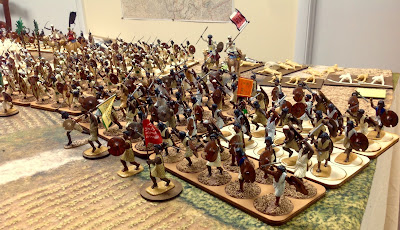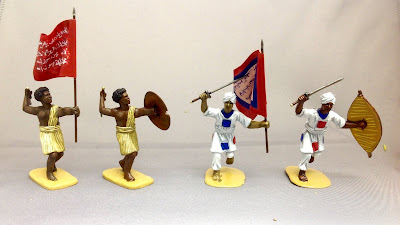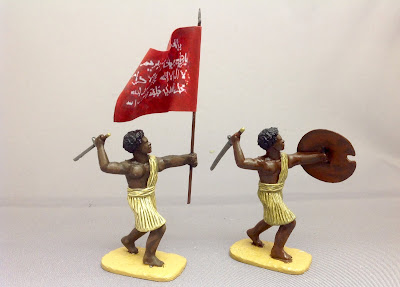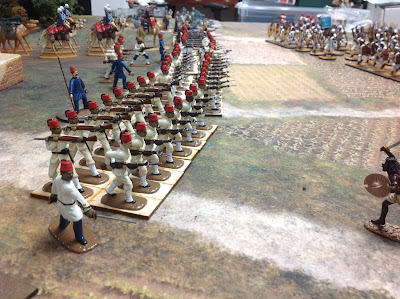 |
| A preliminary mock up of the walls of Khartoum. |
This year's Big Battalion Game will feature a game in the Sudan at the opening of the Mahdi's rebellion. The game will be played over three 6ft by 30ft tables running parallel to each other. We will be using large 54mm toy soldiers for the game. I have sketched a rough map that shows the three game tables and the location of various towns and objectives. The tables run parallel to each other with an aisle gap between each table, in the manner of Peter Gilder's original Wargame Holiday Center set up. The gaps do not exist and so the action carries over from table to table.
 |
| Map of tables for the big Sudan game. There are three parallel tables measuring 6ft wide by 30ft long. |
Sudan Campaign Overview
The British forces will have General Graham based at Suakin (on the Red Sea -rightside table edge), General Gordon in Khartoum (upper left position on the map), and the main British forces at the Korti on the Nile staging area. General Earle's River Column will move up the right bank of the Nile while General Stewart's Camel Corps will move up the left bank of the Nile. The British will also have two river boats at Korti and one boat at Khartoum. There might also be a modest Egyptian garrison at El Teb (I have actually renamed this town Trinkatat since it is a sea port).
The Mahdi's army will be organized under flag commands: Black Flag near Khartoum, Red Flag near Berber, Green Flag at who knows where, and Osman Digna's Beja and Hadendowa tribes near Suakin. If there is a fifth command it will be The Raisuli's Arab/Bedouin tribes at an unkown place. We don't want the British players to know where every Dervish command will be.
The British objective will be to close in on Khartoum and rescue Gordon (major victory), or capture Berber (minor victory) or destroy Osman Digna's army (minor victory). The Dervish objective is to capture Khartoum and fend off any British columns that try to either rescue Gordon or retake the town.
There will be approximately 1,000 Dervish and 300+ British and Egyptian allies in the game.
The game will be played in one full day on a Saturday, hopefully in September, if Covid-19 concerns diminish to a safe level. Otherwise, the game could be deferred into 2021 or as soon as it is considered safe for ten gamers to congregate at close quarters.
The Khartoum Model
One of the terrain features will be the city of Khartoum and part of the scenario will be the relief of Gordon in Khartoum. Accordingly, I am going to need models to create Khartoum on the tabletop.
I created a mockup of the table that features the town so that I can visualize the size of the city and to figure out how many walls, fortifications and buildings will be needed for the game. It also gives me an idea of how many houses can fit inside the area that I have chosen to represent Khartoum.
The following map is from the Osprey Campaign Series book about Khartoum in 1885. The map depicts the town of Khartoum located at the confluence of the Blue Nile (on the right in the map) and the White Nile (on the left in the map) where they form the main Nile River. The rivers provide some natural protection for the town. At the open end of the peninsula formed by the two rivers a long wall runs between the two rivers. The town of Khartoum appears to be well distanced from the defensive walls, unlike those depicted in the movie "Khartoum" with Charleton Heston.
 |
| Map of the Dervish assault on Khartoum. Osprey Campaign "Khartoum 1885 General Gordon's Last Stand" |
Thus Khartoum can be modeled inside a triangular shaped area of the wargame table. The Blue Nile will be the horizontal edge of the table while the White Nile is the vertical edge of the table.
So refer back to the Big Game Map near the top of the page where you will see Khartoum in the upper left corner. That corner will have a right-riangle area measureing 5ft on the Blue Nile edge, 6ft on the White Nile edge, and approximately 7 to 8 feet on the land side perimeter facing the Dervish.
 |
| View of the Khartoum mock up. |
I set up some pieces of plywood boards (6" high by 12" long) to make mock walls. This gives me a good idea of the table space needed for the city as well as the positioning of the defensive walls. You can see one wall segment in the picture that is made by King and Country for toy soldier collectors. I have the main gate and another wall section on order and these components will represent the center and gateway of the defenses. The other needed sections will have to be scratch built. I will use either plywood and bass wood to make the walls, or I might use 1/2" thick foam core with bass wood skeleton for support. Both types of material will take to using wallboard paste (Spackle compound) so that I can give the walls some texture and break up the monolithic look of the plain wood. Wood buttresses will be made to cover up the joins between the wall segments.
The walls will need firing platforms for the infantry and probably two artillery positions. Artillery would seem to be an advantage for the Egyptians, but when you look at the model, you can see that the artillery position is probably the weakest portion of the wall because it has fewer men in that space with which to employ as defenders once the Dervish start pushing ladders up the walls. There will also be plenty of buildings inside the city from which the defenders can hole up in should (when) the Dervish pour over the walls.
I am making good progress on the painting of my Dervish army using Armies In Plastic 54mm plastic toy soldiers. Similar AIP figures have been painted for the Egyptian army, which will defend Khartoum.
As of today, I have the following Dervish plastic units:
Beja #1 60 figures
Beja #2 30 figures of 60
Ansar #1 60 figures
Ansar #2 24 figurs of 60 (round shield - swordsmen)
Ansar #3 24 figures of 60 (wicker shields - swordsmen)
Ansar #4 24 figures of 60 (spearmen )
Riflemen 20 figures of 60
Total figures painted : 238 foot plus 5 standard bearers
The following Egyptians and British have been painted:
Egyptians 48 figures 64 (organized into "companies" of 16 figures)
Naval Brigade 16 sailors (one company)
Infantry 16 men (one company)
Camel Corps 6 mounted on camels (of 48 in total)
Royal Artillery: 2 Gatling Guns, 1 12-pounder, and 1 7 poun mountain screw gun
The majority of the armies for both sides will be metal figures, but I'm using plastic figures to bulk out the armies to be more economical.
Last week my custom made bases from Litko arrived - these are for the Egyptians and British - and so I spent more time basing figures than I did painting figures. I used standard "off the shelf" Litko bases for the Dervish army. They are mounted ten figures per movement tray, on 40mm round bases.






































